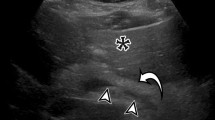Abstract
Four patients with acute pancreatitis presenting with Grey Turner's sign or Cullen's sign have been studied by computed tomography (CT). These observations help confirm the precise anatomic pathways by which the extravasated pancreatic enzymes and their effects lead to these cutaneous discolorations.
Grey Turner's sign is produced by spread from the anterior pararenal space to between the two leaves of the posterior renal fascia and subsequently to the lateral edge of the quadratus lumborum muscle. Communication may be established to the posterior pararenal space and to the structures of the flank wall. The lumbar triangle, a site of anatomic weakness on the flank wall, may serve as a structural predisposition.
Cullen's sign can be seen to be secondary to the tracking of liberated pancreatic enzymes to the anterior abdominal wall from the inflamed gastrohepatic ligament and across the falciform ligament. Another more direct pathway may be extension from inflammatory changes of the small mesentery or greater omentum to the round ligament, and then to properitoneal fat deep to the umbilicus.
Similar content being viewed by others
References
Cullen TS: A new sign in ruptured extrauterine pregnancy.Am J Obstet 7:457, 1918
Grey Turner G: Local discoloration of the abdominal wall as a sign of acute pancreatitis.Br J Surg 7:394–395, 1919
Meyers MA, Whalen JP, Peelle K et al.: Radiologic features of extraperitoneal effusions: an anatomic approach.Radiology 104:249–257, 1972
Merrill JA: Cullen's sign: a historical review and report of histologic observations.Obstet Gynecol 12:317–324, 1958
Evans DM: Cullen's sign in perforated duodenal ulcer.Br Med J 1:154, 1971
Raw SC: Letter to the editor: Cullen's sign in perforated duodenal ulcer.Br Med J 1:505, 1971
Mabin TA, Gelfand M: Cullen's sign, a feature in liver disease.Br Med J 1:493–494, 1974
Capron JP, Civrac D, Delamarre J, Dupas JL, Lorriaux A: Letter to the editor: Cullen's sign after percutaneous liver biopsy.Gastroenterology 73:1185, 1977
Armour RH, Clifton MA, Marsh CH: Balloon catheter control of a ruptured abdominal aortic aneurysm in a patient with Cullen's sign.Br J Surg 65:350, 1978
Fallis LS: Cullen's sign in acute pancreatitis.Ann Surg 106:54–57, 1937
Cox HT: Discoloration of abdominal wall in acute pancreatitis.Br J Surg 33:182–184, 1945
Dickson AP, Imrie CW: The incidence and prognosis of body wall ecchymosis in acute pancreatitis.Surg Gynecol Obstet 159:343–347, 1984
Sigmund WJ, Shelley WB: Cutaneous manifestations of acute pancreatitis with special reference toLivedo reticularis.N Engl J Med 251:851–853, 1954
Reid BG, Kune GA: Accuracy in diagnosis of acute pancreatitis.Med J Aust 1:583–587, 1978
Petřivalský J: Versuche zur Aufklärung des Grundwesens der Verfärbung der vorderen Bauchwand bei akuter Pan-kreasnekrose sowie auch bei geplatzter extrauteriner Gravidität.Zentralblatt für Chirurgie 48:3013–3018, 1931
Rich AR, Duff GI: Experimental and pathologic studies on pathogenesis of acute hemorrhagic pancreatitis.Bull Johns Hopkins Hosp 58:212–259, 1936
Meyers MA: Acute extraperitoneal infection.Semin Roentgenol 8:445–464, 1973
Meyers MA:Dynamic Radiology of the Abdomen: Normal and Pathologic Anatomy third edition. New York, Berlin, Heidelberg, Tokyo: Springer-Verlag, 1988
Feldberg MAM:Computed Tomography of the Retroperitoneum: An Anatomical and Pathological Atlas with Emphasis on the Fascial Planes. Boston, The Hague: Martinus Nijhoff, 1983
Waring HJ, Griffiths HE: Acute pancreatitis.Br J Surg 11:476–490, 1924
Raptopoulos V, Kleinman PK, Marks S Jr et al.: Renal fascial pathway: posterior extension of pancreatic effusions within the anterior pararenal space.Radiology 158:367–374, 1986
Swartz WT: Lumbar hernia. In Nyhus LM Condon RE (eds),Hernia second edition. Philadelphia: J.B. Lippincott, 1978, pp 409–426
Lawdahl RB, Moss CN, Van Dyke JA: Inferior lumbar (Petit's) hernia.AJR 147:744–745, 1986
Baker ME, Weinerth JT, Andrian RT et al.: Lumbar hernia: diagnosis by CT.AJR 148:565–567, 1987
Oliphant M, Berne AS: Computed tomography of the subperitoneal space: demonstration of direct spread of intraabdominal disease.J Comp Assist Tomogr 6(6):1127–1137, 1982
Meyers MA, Oliphant M, Berne AS, Feldberg MAM: The peritoneal ligaments and mesenteries: pathways of intraabdominal spread of disease.Radiology 163:593–604, 1987
Oliphant M, Berne AS, Meyers MA: Imaging the direct bi-directional spread of disease between the abdomen and the female pelvis via the subperitoneal space.Gastrointest Radiol 13:285–298, 1988
Feldberg MAM, Van Leeuwen MS: Massa adiposa ligamenti falciformis. InLiber Amicorum CBAJ Puijlaert. The Netherlands: University of Utrecht, 1987, pp 109–115
Kim SY, Lim JH: Extension of hepatoma to the rectus abdominis muscle via ligamentum teres hepatis.Gastrointest Radiol 10:119–121, 1985
Lafortune M, Constantin A, Breton G et al.: The recanalized umbilical vein in portal hypertension: a myth.AJR 144:549–553, 1985
Williams DM, Cho KJ, Ensminger WD et al.: Hepatic falciform artery: anatomy, angiographic appearance, and clinical significance.Radiology 156:339–340, 1985
Author information
Authors and Affiliations
Rights and permissions
About this article
Cite this article
Meyers, M.A., Feldberg, M.A.M. & Oliphant, M. Grey Turner's sign and Cullen's sign in acute pancreatitis. Gastrointest Radiol 14, 31–37 (1989). https://doi.org/10.1007/BF01889150
Received:
Accepted:
Issue Date:
DOI: https://doi.org/10.1007/BF01889150




